June 14, 2017
By G&A Staff
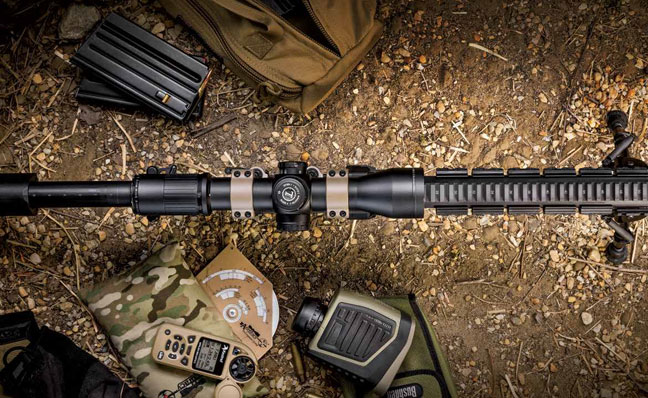
By Todd Hodnett - Photos by Mark Fingar
The definition of long-range shooting has been redefined over the last few years. We are now pushing further than ever, and not just launching bullets in hopes of seeing splash and making second shot corrections until we hit a target. We're doing the math and accurately calculating for elevation at extreme ranges. Wind will be wind, so it will always be hard to ensure a perfect wind call at extreme long ranges, but that is what makes long-range shooting challenging.
Rangefinders are better and more affordable. Scopes can dial more accurately and with more vertical adjustment. Ballistic engines, like the Kestrel AB, give us incredible data. So when we talk long-range shooting, we are really talking about problem solving.
Advertisement
These are a few things we need to seriously consider. For these comparisons, we used a .300 Win. Mag. with 190-grain Sierra MatchKing (SMK) ammunition at sea level DA (density altitude).
ISSUE #1
 RANGE ERROR
RANGE ERROR
Advertisement
Range errors can occur with most laser rangefinders, and they become a huge problem at extended range. Even with an error of only 20 meters, the difference in drop becomes significant.
THE SOLUTION
One of the best ways to avoid this error is to hit and then miss the target with the laser. If the numbers are the same, there is a good chance you are not hitting the target.
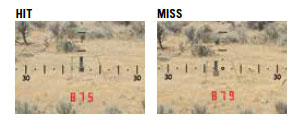
ISSUE #2
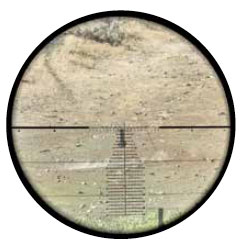 PARALLAX
PARALLAX
Parallax is a huge problem with most of the shooters I train due to their young eyes. By not getting all of the parallax adjusted out of a scope, something as small as .2 mils of parallax could result in a shot being 15.72 inches off.
THE SOLUTION
In addition to focusing the image and reticle onto the same plane by means of a parallax adjustment, another way to remove parallax is to center your eye in the scope. Do this by making sure you have a little scope shadow showing equally all the way around the ocular lens. I even teach students to set up their cheekweld this way. Thus, if you have any
parallax in the scope when you take the shot, you can be assured the reticle is on the target where you perceive it to be.
ISSUE #3
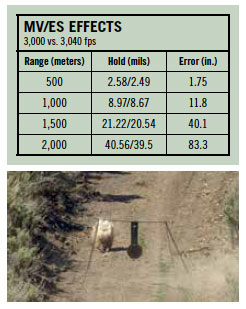 MV / ES
MV / ES
Muzzle velocities (MV) and extreme spread (ES) are huge components of hit probability at long range. When shooting a .308 at a mile, I will ignore shots that strike outside the norm of the group the gun is shooting. Here's why:
Whether you are reloading or have great store-bought ammo, you might expect standard deviation (SD) to be around 7 and ES to be around 20 feet per second (fps). But a lot of ammo may have 40 to 70 fps ES, which, as you can see in the chart, is a point of concern.
THE SOLUTION
Demand quality ammo when shooting long range. Whether it's factory ammo or precision reloads, make sure the ammo produces consistent muzzle velocities in your rifle. If it doesn't, use it for short-range applications instead of long range.
ISSUE #4
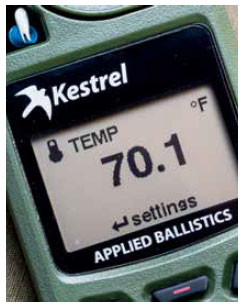 MV AND TEMPS
MV AND TEMPS
Muzzle velocity temperature sensitivity is when the velocity can swing wildly with variations in temperature. We have seen as much as 160 fps in a 100-degree swing. We have even seen more than 50 fps with a relatively minor swing of 20 degrees. This is not a linear adjustment, so shooters must know the temperature sensitivity of the powder being used.
THE SOLUTION
Getting data at sea level and 80 degrees can have a huge adjustment in elevation calculations when going to 8,000 feet DA in 30-degree weather. The ballistic engine will calculate for the DA portion. But one must have MV temperature tables running for the engine to calculate for the powder temperature sensitivity.
This is similar to ES when calculating hit probability, but it's actually greater because all of the bullets will be off by this much instead of one out of five being a flyer.
ISSUE #5
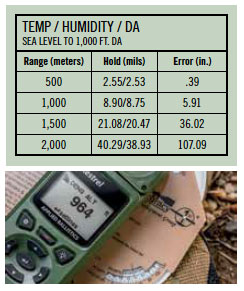 TEMP / HUMIDITY / DA
TEMP / HUMIDITY / DA
In sniper manuals, it states that 20 degrees will give a point of impact (POI) shift of 1 minute of angle (MOA). This is true at 1,000 yards but nowhere else. When looking at DA, understand that temperature will give the largest difference in holds at distance. It takes 14 degrees to change your DA by 1,000 feet.
So let's look at the difference in elevation holds at different distances with 1,000 feet of DA, which is equivalent to a 14-degree temperature change at altitude.
THE SOLUTION
Elevation is consistent, but temperature requires staying on top of changes throughout the day. Inside 500 meters it may not be a big deal, but it begins to be a problem at 1,000 meters and beyond.
ISSUE #6
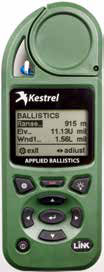 WIND DIRECTION
WIND DIRECTION
Headwinds and tailwinds are of no real consequence at shorter ranges. However, as distances stretch, this variable can affect the time of flight (TOF) to the target, and TOF is everything. We took a 20 mph headwind and tailwind and compared the different actual holds using the Applied Ballistics (AB) engine, which calculates for this variable.
THE SOLUTION
Factor in the direction of wind whenever you shoot long range. Not doing so will result in substantial misses.
ISSUE #7
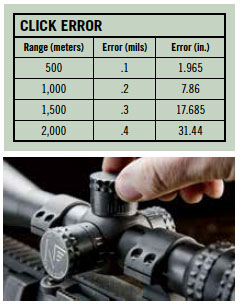 CLICK ERROR
CLICK ERROR
Because many scopes don't dial what you put in and some don't repeat back to zero — dialing 20 mils may only give you 19.6 — you need to perform a calibrated test to measure the impact of each round. At 100 yards, a yardstick is 10 mils. So, if you are square to the target you
should show a 10-mil coverage on the target, and your bullet should move up that much when dialed 10 mils. Any error should be linear.
It could look something like this: At 500 meters, it may be off .1 mil, while at 1,000 meters it may equal .2 mils. Then .3 at 1,500 meters and .4 at 2,000 meters. These click errors quickly accumulate into inches.
THE SOLUTION:
Test your optic and make sure it tracks true. If not, those carefully launched bullets won't land where they should.
ISSUE #8
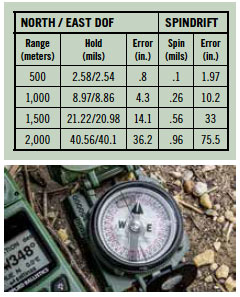 SPINDRIFT AND DOF
SPINDRIFT AND DOF
Spindrift is one of the easiest variables to account for, as the ballistic engines do a good job of giving accurate data for it. But let's look at the same ranges and how much that is in mils and inches.
Direction of fire (DOF), however, is really talking about Coriolis effect. So let's look at a shot without the correct DOF input. Let's say we indicate we are shooting north but we are shooting east, which gives us about half the Coriolis effect.
THE SOLUTION
Make darn sure your ballistic engine knows all of the variables. Spindrift, while quite easy to account for, must be factored into the equation. Also, recognize the direction you are shooting. DOF makes a big difference.
ISSUE #9
 DRAG MODELS
DRAG MODELS
All ballistic engines are not created equal. While standard drag models such as G1 or G7 work fine out to transonic range, they don't predict what happens in the subsonic realm very well.
THE SOLUTION
Use custom curves that Bryan Litz and Applied Ballistics have tested extensively to determine what your bullet is really doing at range. These engines work extremely well.
ISSUE #10
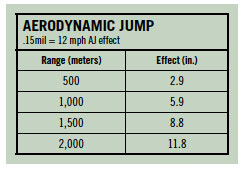 AERODYNAMIC JUMP
AERODYNAMIC JUMP
Aerodynamic jump (AJ), or the deflection of a bullet due to wind direction, can play a huge role when shooting out to distance. If one has not accounted for AJ while truing, this could easily incur an error of 30 fps in the MV. Even if the AJ was accounted for while truing, the effect on the bullet can destroy any chances of making shots at long range.
Let's look at 12 mph, which is small but will account for a .15 mil deviation on target, and see what this means for long range.
THE SOLUTION
Understand what AJ is and how to account for it while shooting long range.
ISSUE #11
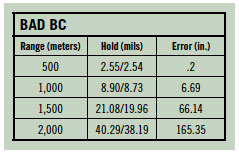 BAD BC
BAD BC
Unfortunately, bullet companies don't always give you the proper BC one should use in a ballistic computer. Instead, they give the BC at the muzzle. This same error will not affect your ability if you true on any targets you engage out to transonic. However, it is not uncommon to see as much as 2 percent deviation from actual BC to what a company may represent as the stated BC.
THE SOLUTION
Instead of trusting listed BCs, run a drag scale factor (DSF) to morph the predictive and actual algorithms back in line in the subsonic regions. This will provide a much more accurate prediction of what the bullet will do at long range.
ISSUE #12
 WIND VELOCITY / COSINE
WIND VELOCITY / COSINE
Always the nemesis of the long gun, cosine (the way we assign value to wind speed if it's not blowing perpendicular to the bullet's path) is a huge problem that gets increasingly difficult with range. Not only is reading wind exponentially harder with range, now we have to get the cosine-determined wind value perfect as well. What I want to show you is math that only relates to a miss estimate of 1 mph. An error of 1 mph wind speed yields this much distance between our expected point of impact and our actual point of impact.
CONCLUSION:
At the end of the day, I am not trying to discourage anyone from extreme longrange shooting. However, I do want to show the challenges in making shots at truly long ranges. And again, I am not talking about shooting and doing corrections until you finally get a hit 50 rounds later. That is not true long range. That is having fun, and there's nothing wrong with that.
There is a different set of skills that allows a shooter to be "on" at extreme ranges in only a shot or two. This is the sought-after skill in long-range shooting. Even though control or even being aware of all the variables may seem overwhelming, this is the challenge, and accurately calculating for each can be a rewarding feeling.
Enjoy articles like this?
Subscribe to the magazine.
Get access to everything Guns & Ammo has to offer.
Subscribe to the Magazine
